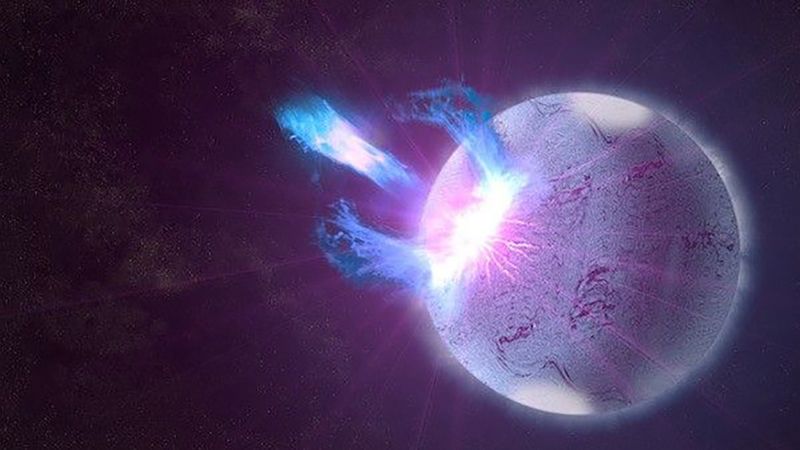Sign up for CNN’s Wonder Theory science newsletter to explore the universe through captivating discoveries, scientific advancements, and other intriguing topics that broaden our understanding of the cosmos.
For decades, astronomers have been delving into the origins of the universe’s heaviest elements, such as gold. New research based on signals retrieved from archival space mission data suggests that magnetars—highly magnetized neutron stars—could offer pivotal clues to their formation. This area of study highlights the complex interplay of cosmic events that lead to the synthesis of these precious metals.
In the early epochs of the universe, around 13.8 billion years ago, lighter elements like hydrogen and helium were prevalent post-Big Bang. Following this primordial phase, massive stars exploded in supernovae, manufacturing heavier elements like iron that subsequently became engendered in the formation of new stars and planets. However, the widespread distribution of gold throughout the universe continues to perplex astrophysicists, presenting a fundamental question about how complex matter originated.
Anirudh Patel, the lead author of a recent study featured in “The Astrophysical Journal Letters,” remarked, “It’s a fun puzzle that hasn’t actually been solved.” Until this point, the cosmic production of gold had only been attributed to the collisions of neutron stars. A notable event in 2017, where two neutron stars collided, resulted in significant repercussions, including gravitational waves and light emissions that indicated the presence of heavy elements such as gold, platinum, and lead. This phenomenon, referred to as a kilonova, showcased the capacity of these cosmic collisions to act as “factories” for gold.
Eric Burns, an assistant professor and astrophysicist at Louisiana State University, noted that most neutron star mergers likely occurred within the last several billion years. However, groundbreaking findings from 20-year-old data from NASA and European Space Agency telescopes propose an earlier source of gold creation: magnetars, which formed much earlier in the universe’s timeline. Given the intense density of neutron stars—where just a teaspoon of material weighs around a billion tons on Earth—magnetars possess extraordinarily potent magnetic fields, rendering them some of the most unusual stellar remnants.
The formation mechanics of magnetars are still an enigma, but scientists hypothesize that they emerged shortly after the universe’s first stars, roughly 200 million years post-Big Bang, or about 13.6 billion years ago. Magnetars occasionally unleash intense radiation in what are termed “starquakes.” These cosmic quakes mirror geological earthquakes on Earth, where stress builds up beneath a surface until it releases energy. The resultant starquakes can release short bursts of X-rays and induce extraordinary activity in magnetars, similar to Earth’s seismic events.
Amid their quest for understanding magnetars, researchers uncovered evidence suggesting the ability of a magnetar to eject material during a giant flare. While they lacked a definitive explanation for how the ejection occurs, it is believed that the heating effect of these flares propels crust material at elevated speeds. Previous research theorizes that these explosive conditions could be conducive to the generation of heavy elements.
The research team pursued the link between magnetar flares and the formation of heavier elements, analyzing various light wavelengths. Burns hypothesized that these flares might produce traceable gamma rays. By examining gamma-ray data from a significant magnetar flare observed in December 2004, which had been recorded by the now-retired INTEGRAL mission, the researchers discovered a match between expected gamma-ray production from their models and the recorded signals.
Although Dr. Eleonora Troja, an associate professor at the University of Rome and an expert in neutron star collisions, noted that this new evidence regarding gold production from magnetars lacks the robustness seen in previous findings, she acknowledged that it opens a new line of inquiry regarding alternative pathways for heavy-element synthesis. Troja expressed skepticism about categorically stating that a new source of gold has been discovered but recognized the merit in continuing this line of research.
The researchers posit that magnetar flares could account for up to 10% of elements heavier than iron in our Milky Way Galaxy. To further investigate this hypothesis, future missions, such as NASA’s upcoming Compton Spectrometer and Imager, expected to launch in 2027, may play a crucial role. Designed to observe giant magnetar flares and identify the elements produced within, this telescope aims to broaden astronomers’ searches for additional sources of heavy elements across the cosmos. The intersection of theoretical research and observational data continues to illuminate the mysteries surrounding the formation of elements throughout the universe.



